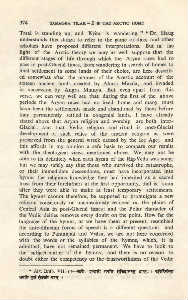Page 593 - Lokmanya Tilak Samagra (khand 2)
P. 593
374 SAMAGRA TILAK - 2 • THE ARCTIC HOMB
Tretc\ is standing up, and Krita is wandering. " • Dr. Haug
understands this stanza to refer to the game of dice, and other
scholars have proposed different interpretations. But in the
light of the Arctic theory we may as well suppose that the
different stages of life through which the Aryan races had to
pass in post-Glacial times, from wandering in search of homes to
final settlement in some lands of their choice, are here describ-
ed somewhat after the manner of the A vestic account of the
sixteen ancient lands created by Ahura Mazda, and invaded
in succession by Angra Mainyu. But even apart from this
verse, we can very well see that during the first of the above
periods the Aryan races had no fixed home and many must
have been the settlements made and abandoned by them before
they permanently settled in congenial lands. I have already
stated above that Aryan religion and worship are both inter-
Glacial; and that Vedic religion and ritual is post-Glacial
development of such relics of the ancient religion as were
preserved from the general wreck caused by the Ice Age; and
this affords in my opinion a safe basis to compare our results
with the theological views mentioned above. We may not be
able to fix definitely when each hymn of the Rig-Veda was sung;
but we may safely say that those who survived the catastrophe,
or their immedidate descendants, must have incorporated into
hymns the religious knowledge they had inherited as a sacred
trust from their forefathers at the first opportunity, that is, soon
after they were able to make at least temporary settlements.
The hymns cannot therefore, be supposed to promulgate a new
religion consciously or unconsciously evolved on the plains of
Central Asia in post-Glacial times; and the Polar character of
the Vedic deities removes every doubt on the point. How far the
language of the hymns, as we have them at present, resembled
the ante-diluvian forms of speech is a different question; and
according to Pantanjali and Vyc\sa, we are not here concerned
with the words or the syllables of the hymns, which, it is
admitted, have not remained permanent. We have to look to
the subject-matter of the hymns; and there is no reason to
doubt either the competency or the trustworthiness of the Vedic
• Ait. BrAh. VII, 15-ift{e: ~ ~'fftr ~~ i[ffi: I \3~~tll
~~~"W(.II

